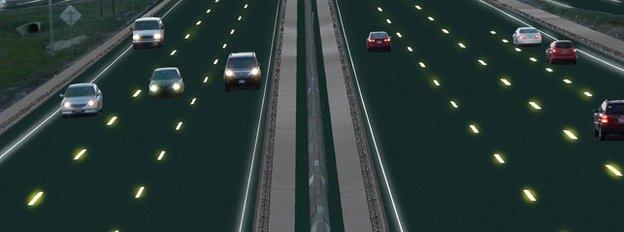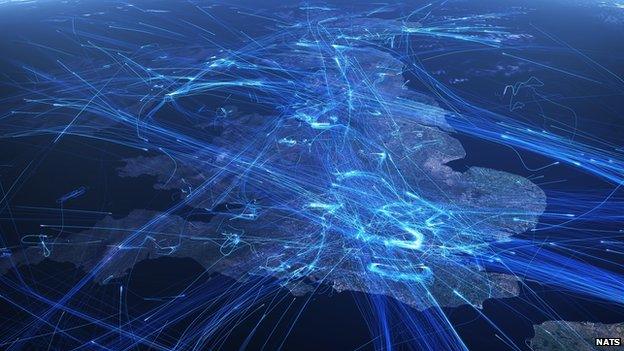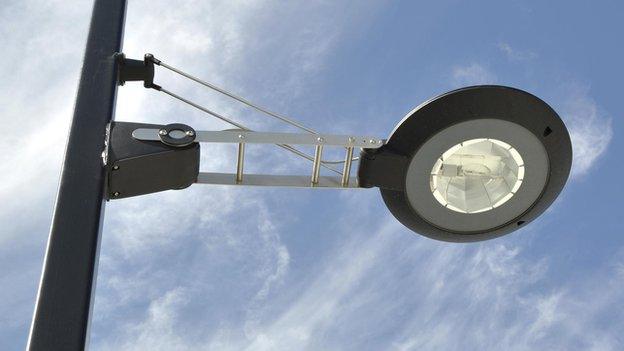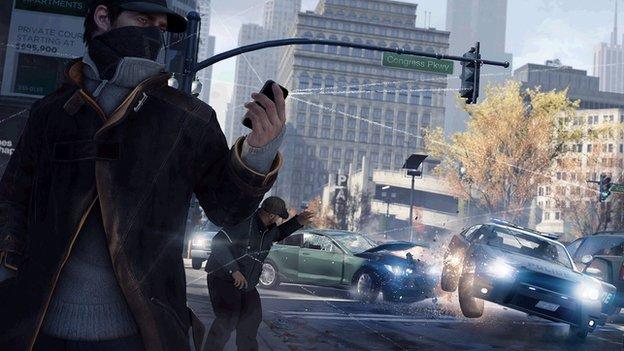Tomorrow's cities: Towards the congestion-free city
- Published

Will the driverless cars of Milton Keynes be assertive or polite?
Neil Fulton is debating what sort of persona to give the driverless cars that are soon to hit the not-so-mean streets of Milton Keynes.
"Are they going to be polite and let people pass in front of them?" he asks.
"There is a danger that if they are too polite, they wouldn't make any progression. But, on the other hand, we couldn't have aggressive vehicles that present safety issues so we might be better targeting assertive vehicles that provide some sort of audible or visual warning when they are going to do something."
Mr Fulton heads a project known formally as the Lutz (low carbon urban transport zone) Pathfinder programme, which will see three full-electric and driverless pods tested on the streets (or more accurately the pavements) of Milton Keynes by the end of 2015.
If successful, a bigger fleet will be ordered and 100 vehicles could go into public service by 2017. They will act as taxis around the city.
Transforming cities
For many, the mere idea of driverless cars is a leap of faith that they are not yet prepared to take, but the arguments for such transport are growing more persuasive by the day.
"You won't have to park your own car and you can sit back, read the newspaper or do emails while it is driving you," said Prof John Miles, a consultant from Arup who worked on the Milton Keynes project.
And it is not just our personal lives that are likely to change.
"It will completely transform transport and congestion in our cities. It used to be that cities were subjugated to the car but now we have the opportunity to do precisely the opposite - tailor our transport to fit our beautiful cities."
He envisages a future 20 or 30 years hence when autonomous city transport pods will co-exist with conventional cars.
"For longer journeys, we may still use our cars but in cities we will use transport systems which utilise driverless technology," he said.
Such vehicles are likely to be smaller than traditional cars, optimised to travel the most efficient routes and able to drive closer to each other, potentially freeing up much more road capacity.
"You couldn't trust a human being to drive a few feet in front of another car but you could trust an autonomous one," he said.
So why choose Milton Keynes as the UK's first test-bed for such technology?
"It happens to have a well-defined city centre with lots of pedestrian space and a progressive, forward-thinking council," explained Prof Miles.

Bright future?

Will part of our driving future be solar cars on solar roads?
Students at the Eindhoven University of Technology have developed what they call the world's first solar-powered family car, called Stella.
It can seat four people and travel for up to 250 miles without sunshine and on a sunny day, when fully charged, up to 420 miles.
It recently completed a journey from Darwin to Adelaide using nothing but the energy of the sun.
Such cars may one day travel on solar-powered roads if a crowdfunded campaign to embed solar panels on roads succeeds.
Solar Roadways is the brainchild of husband-and-wife team Scott and Julie Brusaw.
They claim that if the US built a nationwide solar road infrastructure it would generate more electricity than the country currently uses.
The project has been backed by Google and the US Federal Highway Administration.

The revolution in driverless cars is already well under way. Google expects to have its self-drive cars, which have already clocked up more than 300,000 miles, on the roads by 2017. And car manufacturers from Volvo to Tesla have promised their own autonomous vehicles by about the same time.
Already new cars coming off the production line have more in common with computers than the metal structures of old. Cruise control is pretty standard and, predicts Prof Miles, will soon give way to cars that ask 'Do you want me to take over?'
Change will be slow and subtle he thinks.
"We will keep on pretending that the driver is still in charge until it becomes apparent that they want to let the car drive itself," he said.
Surprisingly the legislative jump required to allow such vehicles is happening faster than many thought possible. In the US, several states have passed laws allowing such vehicles on the roads, Sweden has approved similar laws for Volvo and the UK too is promising to ease the way for Milton Keynes and other driverless cars.
But despite both the technology and the law being ready, not many cities are prepared to embrace such radical change.
Many have decided to take a different route to solving their traffic problem, installing intelligent traffic lights that can decide when to let traffic flow and when to stop it.
Others are using sensors embedded in the roads which can talk to traffic management systems and suggest different routes when there are roadworks or accidents.
Prof Miles thinks that such spending could be short-sighted because the cars being developed will be far smarter than the infrastructure around them.
"We won't need traffic lights at all in the future. The car will know all about the other cars around it."
Beautiful data

Some of the data visualisations, like this one showing planes taking off and landing, are both terrifying and strangely beautiful
Milton Keynes, as well as leading the UK's driverless car revolution, is also home to the Transport Systems Catapult, a group set up by government to find innovative ways to improve current transport problems and commercialise solutions.
Much of its work centres around analysing traffic data.
It boasts a fancy control room into which flows a massive amount of data about several types of movement including the flow of boats around the UK's ports, the number of people walking around London at any given time and real-time take-offs from airports around the country.
The information is often put together in quite stunning visualisations and the hope is that developers and others can come up with clever ways to use it to create new apps and services for citizens.
Another project in the unit aims to demonstrate the cause and effect of traffic flow.

A smart game lets users control Manchester traffic flow
Looking down on a touchscreen table, on to which is projected the traffic flowing around Manchester city centre, users could be forgiven for feeling rather like the ancient gods of Olympus.
They can manipulate the flow simply by placing down a counter saying "roadworks" or "public event" and watch the immediate effects on the traffic.
The centre is also experimenting with so-called sentiment mapping, gathering the tweets and other social media interactions related to the eight major rail operators which serve London and representing them as coloured blocks on a map - with each colour representing a different mood, aiming to show how customers rate each train company on a daily basis.
It is all part of what Steve Yianni, chief executive of the Transport Systems Catapult, calls intelligent mobility which he hopes can "harness new technologies to create seamless journeys, where transport is smart and connected, and delays and congestions are a thing of the past".
Parking apps

What do citizens want from a smart city? A parking space would be nice
Until then, congestion is one of the biggest problems facing cities and up to 10% of it is caused by people driving around looking for somewhere to park.
So an app that allows you to find a parking space from someone that is actually in that space and prepared to reserve it until you get there for a small fee might seem like a great idea.
Not according to the city of San Francisco which this summer banned the use of MonkeyParking which did just that, claiming the app created "a predatory private market for public parking spaces".

As with traffic lights and roads, cities are keen to control how people use their infrastructure.
Many have started to roll out sensors in parking spaces with a view to using the data to create their own parking apps or offer variable parking prices depending on demand and availability.
For the time being, the use of smart technology and data analysis seems to be the way cities want to deal with their traffic issues and it will be a brave city that rips out traffic lights to make way for driverless cars.
But if we are ever to achieve the dream of congestion-free cities, a more radical approach may be needed and the solution seems tantalisingly close for those bold enough to grab it.
- Published25 September 2014

- Published11 September 2014
